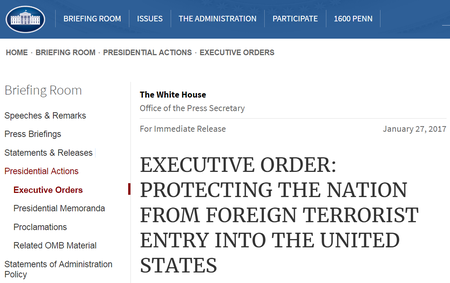National Civil Rights Groups Join Detroit Lawsuit
Likening Trump travel ban to Japanese internment, attorneys file supporting briefs in challenge to president’s order.

A group of national civil rights organizations are supporting a lawsuit filed in U.S. District Court in Detroit by the Arab American Civil Rights League and several plaintiffs challenging President Trump’s ban on travel from seven Muslim-majority countries.
“This executive order by this president is the beginning, the foot in the door or racism in our policies around immigration and immigrants,” says Detroit attorney Bill Goodman, who along with the groups filed a supportive brief in the case this week.
The legal organizations include: The Fred T. Korematsu Center for Law and Equality, named for a Japanese American who fought internment during World War II, Asian Americans Advancing Justice, the National Native American Bar Association, and the South Asian Bar Association of North America.
Here’s the brief the group’s filed:
Click on the player above to hear the full audio of Goodman’s conversation with WDET’s Sandra Svoboda. Here’s a full transcript of it:

Bill Goodman: We are a group of civil rights organization, led by the Korematsu Center — Asian Americans, Native Americans and others — who are trying to call attention to the fact that this executive order by this president is the beginning, the foot in the door or racism in our policies around immigration and immigrants, and it’s dangerous and it goes back to a long history of where this happened starting with the Chinese ban case, which led to Plessy v. Ferguson, which supported segregation in the United States which led to the K case itself.
Sandra Svoboda: You mentioned the Korematsu Center for Law and Equality out of Seattle is joining in your brief in the Detroit court. Talk a little bit about the history of that organization.
BG: Fred Korematsu was one of the people who was detained during World War II simply because he was a Japanese American. It was the most disgusting example of racism at work through presidential orders that we can imagine until now. He and the Center are completely involved in raising this issue and the consciousness of the way in which racism can be used to violate the Constitution, violate the Bill of Rights and detain people simply based upon ethnic origin and race.
SS: The president’s executive order on immigration is on hold because of cases on the West Coast. Why are cases like this one still progressing in federal courts around the country?
Here’s the Feb. 9 order in that case:
BG: They were all filed simultaneously in various place involving different people who have been detained, whose travel has been interrupted and interfered with. The 9th Circuit case, the one from the West Coast is the one that has gotten the furthest, and you’re right, it applies nationally. We don’t know what’s going to happen with that, whether there will be an en banc determination by the 9th Circuit so these cases are still proceeding. These people still have a basis and standing for complaining about the way in which their lives have been affected.

SS: The executive order when it was issued was described as being about security. It is described by opponents as a Muslim ban. Where do these groups of Asians and Asian Americans and Native Americans that you’re working with fit into that discussion?
BG: They see the danger here, as I said, a foot in the door. What happened with the Chinese ban in the 19th century didn’t affect all Asian people or all people who were even Asian Americans. It only affected only the Chinese. What happened with the detention of Japanese Americans during World War III, again did not affect all Asians, it simply affected Japanese people but it was nonetheless racism. It led to an opinion by the United States Supreme Court which is universally reviled nowadays. This is their concern: that with the beginning of a travel ban that looks primarily at issues of ethnic origin and religion, we know that this will end up in very, very deep water, very toxic water long before we are able to stop it. That’s what history has shown us over the years. That’s the way in which these things progress.
